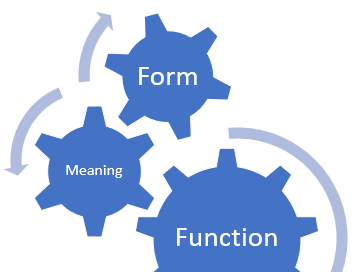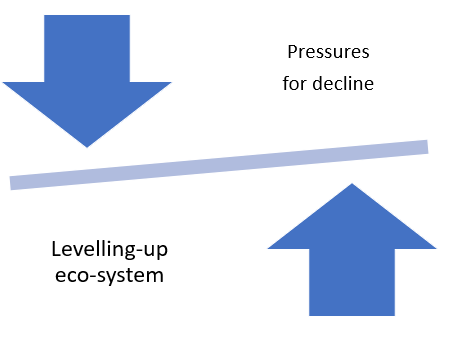Levelling up from the bottom up
Since the economic downturn in the UK in 2008, government policy has become strongly focused on the macro-economic conditions for recovery and the role of local and regional bodies in driving economic growth. Recognizing the widespread inequalities between towns and cities around the country ‘levelling up’ has become a mantra of the present government following 2019 general election. It is not the first time the term has been used although hitherto it was in policy debates on the promotion of social mobility and extending educational opportunity.
In its current manifestation, levelling up policy aims to reduce the primarily economic ‘imbalances’ between areas and social groups across the UK without acting to the detriment of more prosperous areas located mainly around London and in south-east England. The policy is backed by resources from a new government Levelling Up Fund for which local authorities can bid for capital investment and local infrastructure projects. There are other funds included within the levelling up initiative, namely the Community Renewal Fund which is focused on skills, employment, local business and communities, and a Towns fund for the improvement of towns.
The results of the first round of the bidding process have led to criticism of the criteria used in the selection of successful applications and the lack of indicators of outcomes from the programme. More fundamentally the programme has led to criticism that funds are spread too thinly, and doubts that individual local projects could transform local economies or create sustainable long-term employment prospects.
This essay picks up on these issues. The levelling up policy outlined above is essentially a top-down, centrally managed, project-based grant programme. Is this likely to be an effective route to sustainable place-based change at local level and can such local interventions influence levelling-up at area or regional level? Is single project finance enough for meeting long term goals?
Please note I have cast this discussion in a UK frame, but other countries have improvement policies which raise similar issues.
What makes a place?
It is frequently said that the concept of place has 3 essential dimensions - form, function and meaning – which interact to produce its character and identity, or ‘placeness’. Form is concerned with physical features, buildings and infrastructure. Function is concerned with the local economy and use of community resources, whilst meaning focusses on more emotional dimensions such as place identity and attachment for residents and other place ‘users’. Revitalizing towns and neighbourhoods requires attention to all of these, although the priority attached to each may vary from place to place.
Form
The quality of the built environment is the backcloth within which community life takes place. Urban spatial structure has been found to impact on the opportunities for social interaction, on social mobility, on crime rates, on health and many other aspects of community life. It is to be expected that changing the physical features of a neighbourhood will influence patterns of community activity, and set new contexts for local economic opportunities and social and cultural past-times.
Function
The function of a place helps identify its economic and social development and indicates its main activity. Larger towns may well will have more than one function, although historically one was likely to have been the most important in determining its growth and success. Examples of function are market towns, manufacturing towns, residential towns and cultural or religious centers.
Meaning
Meaning is experiential and subjective, concerned with a sense of place derived from or associated with a place, based on lived experience of the place. Places are subject to constant change from outside influences and interventions which will change the sense of place, of attachment to place and to identity associated with place held by different people.
These aspects of place are inter-related. Interventions will change the ‘gearing’ of a place, leading to continuous modification of the relationship between its constituent aspects, as represented below.
‘Levelling up’
Levelling up interventions might be concerned with any or all of these aspects of place. The first round of projects funded through the Government’s levelling up fund were very diverse. Large scale projects include new visitor attractions, infrastructure projects and major town regeneration schemes. Other funded projects include improving transport links, support for community regeneration and restoration of heritage sites.
The pressures on places which are in decline or are areas of deprivation that are the target for these interventions often stem from a loss of function, for example, from reliance on industries which are obsolete such as mining towns, where rationalization of industries in the face of changing technologies has led to re-location or where the growth of opportunities elsewhere has led to population decline, a depleted local skills base and a limited quality of life for those who remain.
The resources and capacities within towns and neighbourhoods are a major factor influencing the outcome of levelling-up interventions. The forces causing decline need to be challenged and replaced by the creation of a new ecosystem capable of securing sustainable economic development and social resilience. A new balance is needed if levelling-up benefits are to be delivered.
Whilst major projects can be expected to produce significant change, there is a question about whether the smaller one-off projects will be sufficient to stimulate the depth of change needed for levelling up whole communities.
What would a Levelling-up eco-system look like?
A levelling-up ecosystem is a blend of social, economic, cultural and political factors within an area which can support and sustain new businesses, the creation of opportunity-based firms and innovative public services, and environmental improvement to raise place quality. The eco-system will need to be one to attract investment to deliver both economic benefits and lifestyle benefits if it is to produce sustainable change. If the elements forming the eco-system are strong enough, then the area’s progress might become self-sustaining and produce a strong place identity alongside other already successful communities.
There will be many elements within such an eco-system, but they can be categorised into domains as illustrated below. The elements shown below are those usually found in an ecosystem designed to drive entrepreneurial activity at city, regional or even state levels. The levelling up ecosystem needs to be flexible to adapt national provisions to serve local needs to bring local change to an extent that brings relative improvement with respect to other areas. The levelling-up eco-system comprises these factors acting in dynamic interaction to drive the allocation of resources which gives confidence to local business to expand, and to new start-up to take off.. It needs strong buy-in from the community to embrace a new positive culture of opportunity in the quality of life.
There are examples among the successful bids in the current levelling-up programme which contribute to all of these elements, but it must be remembered that the programme allows only one project in a local authority area.
Projects can be mapped on to the elements of the levelling-up ecosystem outline above. A significant proportion of the projects relate to the improvement of infrastructure and transport connectivity through for example, improvement to rail links and ferry terminals, road access arrangements and establishing transport hubs. Another group of projects are concerned with the restoration or extension of cultural facilities such as theatres, galleries or arts centres. Others are concerned with town centre regeneration schemes, some building on local heritage features or the restoration of green spaces.
Some schemes are more developmental relating to education and training or innovation opportunities. For example one project was for the establishment of a ‘multiversity’, another for a science discovery centre, and another for a green technology and innovation centre. More generally, another was entitled ‘Broadening aspiration through education and culture’. Others focused on increasing access to sport through, for example the delivery of a sports village or leisure and well-being hubs. These all seem to have potential for community involvement, and improving human and social capital.
A further group had more explicit economic and business objectives through such initiatives as an industrial solutions hub and enterprise campus and a screen industries production village. Some sought to set up new facilities such as major visitor attractions to provide a variety of associated business opportunities.
But will this level-up?
Whilst across the programme there are projects which relate to each of the elements in the ecosystem, in any one place the levelling-up intervention can only address a limited number and can only therefore have a limited effect on the working of the local ecosystem. Every intervention from the levelling-up fund brings additional finance to the area which allows work to be taken forward on a specific local project, and this in itself is welcome and in the short-term at least will provide employment opportunities in construction and project staffing.
Many of the projects can be expected to contribute in particular ways to the quality of life within an area. Not so prominent amongst the areas are projects that directly relate to social capital building or education and training, or directly to facilities for the encouragement of innovative business development. It is these latter projects which are necessary to give an uplift to the local economy, encourage and support new start-ups or attract employers from elsewhere. Reflecting on his experience reporting on regeneration in many US towns and cities, Oscar Abello of the Next City organization is clear that simply bringing money into places where it hasn’t been before or at least not for a while does not replace what historically marginalized communities have lost. A strong sense of communal agency is needed too.
Better Places?
It is instructive to look at the levelling-up programme against the three dimensions of place described earlier. At the risk of over-generalization, it would seem that few of the projects in the programme impact on the function dimension of place. Only where funding brings major new nationally relevant initiatives to a place will the function of places in receipt of grants be significantly changed. Some projects promote a new emphasis on particular economic sectors such as green technology or screen industries, but many aim to help places perform existing functions better through improved connectivity business support facilities.
The majority of grants will influence the form dimension of place with re-modelled townscapes, community resources and green spaces. These will provide a changed backcloth for community activity and lifestyle.
The third dimension of place relates to meaning of place for those who live and work there. Many of the results of the programme will lead to visible changes to their environment, but the extent to which such changes lead to altered perceptions and emotional connections with a place is less clear. A few projects explicitly set out to broaden aspirations through promoting education, culture and heritage. For most places receiving levelling-up finance the extent to which this leads to more positive place identity and place attachment in the community is uncertain. Without this positive emotional commitment to their place, other changes may have less impact and be less sustainable. The balance between pressures of decline and levelling-up may not shift too much. Securing community commitment to change in their place is essential. Levelling up depends on building from the bottom up.






